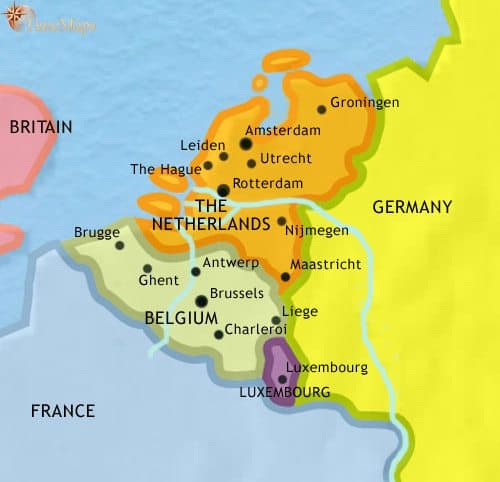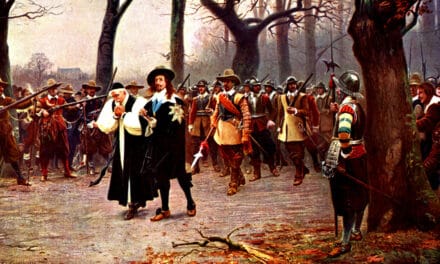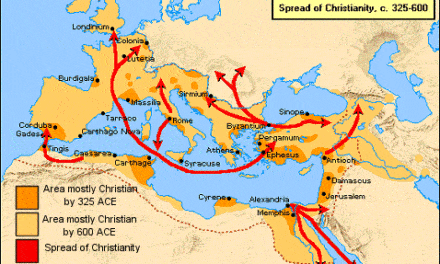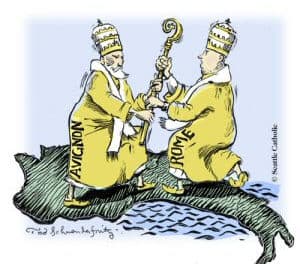This episode is titled “In the Low Countries.”
Belgium, The Netherlands, and Luxemburg are referred to as “the Low Countries.” The get this name because laying along the coast NW of Germany and NE of France, they are at or slightly below sea level. That and there’s not really much in the way of mountains. There are some low hills, but for the most part the region today called Benelux is pretty flat.
During the Reformation, as in most of northern Europe, Protestantism in the low countries gained adherents early on. In 1523, in Antwerp, the first two Protestant martyrs were burned. From that point on, there’s solid evidence Protestantism made headway across the region. But the political situation there hitched the advance of Protestantism to a long and bitter struggle for independence.
Near the mouth of the Rhine River, there was a region known as the Seventeen Provinces, in what today is the Netherlands, Belgium, and Luxembourg. These territories were part of the holdings of the Hapsburgs. The Holy Roman Emperor Charles V was born and raised there. So he was well-liked by the people, and under his rule the Seventeen Provinces grew close -er. That is,c loser than they’d been before, but not in fact, close.
Their political unity was fragile since each province had a unique identity, traditions, and ruling nobles. Cultural unity was lacking since the French-speaking south and Dutch-speaking north were at ever at odds. Then there was the problem of ecclesiastical complexity with bishops vying with one another other over who’s domain was the most prestigious.
In 1555, Charles placed the Seventeen Provinces under the rule of his son Philip. He assumed the young man would continue his rule of slow-paced unification. But it was under Philip that what little unity there was cam apart. The low countries honored Charles because of his Flemish roots. Flemish was his mother-tongue. But Philip was raised in Spain. Both his language and outlook were Spanish. In 1556, having received the crown of Spain, he became Philip II, and made it clear his most important possession was the Iberian Peninsula. The Low Countries were put at the service of Spain and her interests. This provoked the resentment of the Seventeen Provinces, who resisted Philip’s efforts to complete their unification, and to treat it as part of the hereditary possessions of the Spanish crown.
Even before the Reformation broke out in the Low Countries, there’d been a strong movement toward reform. This was the birthplace of the Brethren of the Common Life, and of the greatest of humanist reformers, Erasmus of Rotterdam. One of the major themes of the Brethren was the reading of Scripture in the native language of the people. So the Protestant Reformation found fertile ground in the Low Countries.
It wasn’t long before Lutheran preachers entered the area, gaining large numbers of converts. Then the Anabaptists made headway. Last, there was an influx of Calvinist preachers from Geneva, France, and southern Germany. Eventually, these Calvinist preachers were most successful, and Calvinism became the main brand of Protestantism.
That’s not to say the advance of the movement went without opposition. Charles V took strong measures against the spread of Protestantism there. He issued edicts against it, in particular against Anabaptists. The frequency with which these edicts followed one another is proof of their failure to stem the tide of Protestant conversions. Tens of thousands died for their faith. Leaders were burned, their followers beheaded, and many women were buried alive. But, in spite of such punishments, the Reformation continued its advance. Toward the end of Charles’s reign there was growing opposition to his religious policies. But Charles was a popular ruler, and many in Central Europe were convinced Protestants were heretics who deserved their punishment.
Philip, on the other hand, never popular in the Low Countries, prompted even greater ill will through a combination of folly, stubbornness, and hypocrisy. When he returned to Spain and left the Provinces under the regency of his half-sister Margaret of Parma, he sought to strengthen her authority by quartering Spanish troops in the Low Countries. These troops were sustained financially by the locals. Clashes soon developed between the Spanish soldiers and the natives, who chafed under the presence of foreign troops. Since there was no war requiring their presence, the only possible explanation was that Philip doubted their loyalty. And if they were going to be assumed to be disloyal, why not actually BE disloyal?
To this was added the appointment of new bishops given inquisitorial powers. But the locals said, “Wait! What? We’ve heard about the Spanish Inquisition. We do NOT want that here! NO way, NO How! Our King isn’t treating us like citizens; He’s treating us like the worst kind of enemy.”
Philip and his regent Margaret paid no attention to their most loyal subjects. William, Prince of Orange, a close friend of Philip’s father, and the Count of Egmont, who’d given outstanding military service to Charles, were made members of the Council of State. But they were mere figureheads who were never consulted. Philip and Margaret took advice instead from a foreign advisor named Bishop Granvelle, whom the people of the Low Countries blamed for every injustice and humiliation they suffered. After repeated protests, the king recalled Granvelle. But it soon became clear Granvelle had really only carried out Philip’s instructions. Philip was to blame.
The leaders of the Seventeen Provinces sent the Count of Egmont to Spain to carry their grievances to the King. Philip received him with honors and promised change. Egmont returned home, confident things would turn around. But when he opened the letter from the King to be read to the other leaders, it contradicted everything the king had promised. Philip had already sent Regent Margaret the decrees of the Counter Reformation Council of Trent. Protestantism was to be rejected. All who opposed them were to be executed.
These orders caused massive unrest. The magistrates of the Seventeen Provinces had no mind to execute the vast number of their fellow citizens the king decreed should die. In response to Philip’s commands, hundreds of the nobility and joined in a petition to Margaret that such policies not be implemented. Margaret received them, and when she evidenced signs of an agitation so great her attendants feared she might have a seizure, one of her courtiers calmed her by calling the nobles “beggars.”
That label captured the imagination of local patriots. If their oppressors thought them beggars, they’d bear that name proudly. The leather bag of a beggar became the symbol of rebellion. Under it the movement, until then limited to the nobility and merchant class, took root among the entire populace.
Before coming to outright warfare, the movement took on a religious overtone. There were frequent outdoor meetings in which Protestantism and opposition to the authorities were preached under the protection of armed Beggars. In fear of greater disturbances if they didn’t allow them, Regent Margaret’s troops allowed these meetings. Then roving bands of iconoclasts invaded churches, overturned altars, and destroyed images and symbols of the Roman Church.
Finally, the magistrates appealed to William of Orange. Thanks to his pleas, and those of his supporters, the violence dimmed, and the iconoclasts ceased their attacks. The Inquisition was suspended and a limited freedom of worship was permitted.
But Philip was not the kind of ruler to be swayed by his subjects’ opposition. He loudly declared he had no desire to be a “lord of heretics.” Appealing to the old principle that there was no need to keep faith with the unfaithful he set about to re-assert control of those troublesome low countries. While promising to abide by the agreements reached in the Provinces and pardon the rebels, he raised an army with which to force his will on the Low Countries. William of Orange, aware of the king’s duplicity, advised his friends to join in armed resistance. They foolishly put their trust in the king’s promises while William followed his own advice and withdrew to Germany.
The storm arrived quickly. Early in 1567, the duke of Alba invaded the low countries with an army of Spanish and Italian troops. The king gave him powers similar to Regent Margaret who became a figurehead. Alba was the true ruler. His mission was to obliterate all rebellion and heresy.
Protestants were condemned for their heresy, and Catholics for not having been sufficiently firm in resisting heresy. Even to express doubt as to Alba’s authority was high treason. The same charge was brought against any who opposed the reorganization of the church, or declared the provinces had rights and privileges the king couldn’t overturn. So numerous were those put to death under these ordinances chroniclers of the time speak of the stench in the air, and of hundreds of bodies hanging from trees along the roads. The counts of Egmont and Horn were arrested and brought to trial. Since William of Orange was not available, Alba captured his 15-year-old son and sent him to Spain. William responded by investing all his financial resources in raising an army, mostly German, with which he invaded the Low Countries. But Alba defeated him repeatedly and, in retaliation, ordered the execution of Egmont and Horn.
Alba was in full command of the situation when the rebels received support from an unexpected quarter. Orange granted licenses to privateers, in the hope they’d harass Alba’s communication and supply lines back to Spain. These pirate Beggars of the Sea achieved a measure of organization Philip’s naval forces couldn’t contain. Queen Elizabeth of England gave them support by allowing them to sell their booty in English ports. In a brilliant maneuver, the Sea-Beggars captured the city of Brill and, after that, their ongoing success made them a legend that inspired the patriots who resisted on land. Several cities declared themselves in favor of William of Orange, who once again invaded the provinces, this time with French support. But the French also were dealing in treachery, and William was approaching Brussels when he learned of the Massacre of St. Bartholomew’s Day. That put an end to collaboration between Protestants and the French crown. Lacking funds and military support, William was forced to disband his mercenary troops.
Alba’s vengeance was terrible. His armies took city after city, and repeatedly broke the terms of surrender. Prisoners were killed for no other reason than revenge, and several cities that had resisted were put to the torch. Women, children, and the elderly were indiscriminately killed along with the rebels. Soon every rebel stronghold was in Alba’s hands.
It was only on the sea that the rebels remained strong. The Sea Beggars continually defeated the Spanish, at one point capturing their admiral. This made it difficult for Alba to receive supplies and funds. The Spanish troops began showing signs of mutiny. Tired of the long struggle, and bitter because Spain didn’t send the resources he required, Alba asked to be appointed elsewhere.
The new Spanish general, Luis de Zúñiga y Requesens, had the wisdom to exploit the religious differences among the rebels. He sought a separate peace with the Catholics of the southern provinces, driving a wedge between them and the Protestants, who were more numerous in the north. Up to that point, the religious question was just a minor one among many in what was really a national rebellion against foreign rule. William of Orange, the leader of the uprising, was a liberal Catholic until his exile in Germany. Then in 1573 he declared himself a Calvinist. But Requesens’s policies underscored the religious element of the struggle, neutralizing the Catholic provinces of the south.
The Protestant cause was desperate as its armies were repeatedly defeated. Its only hope was the Beggars of the Sea. The main crisis came at the Siege of Leiden. The important trade center declared itself for Protestantism. The Spanish surrounded it. An army sent by William of Orange to break the siege was defeated, and 2 of William’s brothers were killed. All was lost when William, whose enemies called him William the Sly, suggested that the dikes be opened, flooding the land around Leiden. This meant the destruction of many years of hard work, and the loss of a great deal of farmable land. But the citizens agreed. In spite of a shortage of food, the besieged continued their resistance during the four months it took the sea to reach Leiden. Riding in on the flood, the Sea Beggars also arrived, shouting they’d rather be Turkish than Popish. Lacking naval support, the Spanish were forced to abandon the siege.
At that moment, Requesens died. His troops, having neither leader nor pay, mutinied, and set about sacking the cities of the Catholic south, which were easier prey than those of the Protestant north. This served to reunite the inhabitants of the Seventeen Provinces, who, in 1576, agreed to the Pacification of Ghent. This alliance among the provinces made it clear what was at stake was national freedom, not religious differences. The agreement was hailed by William of Orange, who’d repeatedly argued religious dogmatism and sectarian intolerance were an obstacle to the unity and freedom of the low countries.
The next governor was Don Juan de Austria, an illegitimate son of Charles V, so half-brother of Philip II. Although he was one of the most admired military heroes in Christendom for his defeat of the Turks at the Battle of Lepanto, he was not allowed to enter Brussels until he’d agreed to the stipulations of the Pacification of Ghent. But Philip II would not give up the struggle. A new army was sent into the region, and once again the southern provinces abandoned the struggle. Then the northern provinces, against the advice of William of Orange, formed a separate league for the defense of their faith and freedom.
The struggle dragged on for years. Though they were firmly in control of the south, the Spanish could not conquer the north. In 1580, Philip Il issued a proclamation promising a reward of 25,000 crowns and a title of nobility to anyone who would kill William the Sly. William and his supporters responded with a formal declaration of independence. Three years later, after several unsuccessful attempts, an assassin on a quest for the reward was able to kill William. And once again, Philip proved untrue to his promise, at first refusing to pay the reward, then paying only a portion of it.
Philip hoped William’s death would put an end to the rebellion. But William’s nineteen year old son Maurice, proved to be a better general than his father, and led his troops in several victorious campaigns.
In 1607, almost a decade after the death of Philip II, Spain decided her losses in the struggle weren’t worth the effort and cost of continuing the war, and a truce was signed. By then, the majority of the people in the northern provinces were Calvinist, and many in the north equated their faith with their nationalist loyalty, while the southern provinces remained Catholic. Eventually, religious, economic, and cultural differences led to the formation of three countries; the Netherlands, which were Protestant, and Belgium and Luxembourg, both Catholic.





